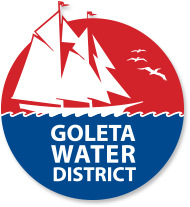
In the Goleta Valley recycled water plays a critical role in drought planning since it remains available even during periods of low rainfall. Since 1995, the District has served recycled water for irrigation and restroom facilities through a partnership with the Goleta Sanitary District. The District’s largest recycled water customers are UCSB, and several golf courses in the area. Using recycled water for irrigation and other non-potable uses helps to conserve and stretch the District’s potable water supplies, improving supply reliability and keeping costs lower for customers.
While the majority of recycled water produced today is used for irrigation, to support long term sustainability and reliability the District is actively pursuing grant funding opportunities and local partnerships to identify projects that can expand the uses of recycled water to realize its full potential as a permanent supply source for the community.
Under a partnership with the Goleta Sanitary District (GSD), the District serves approximately 1,000 acre feet per year (AFY) to 30 customers in the Goleta Valley. Recycled water represents approximately 7% of District supplies, and every drop of recycled water used conserves potable water supplies for drinking, health and safety. As a result of regulations limiting the use of recycled water as currently treated, and constraints in the existing recycled water distribution system, however, the District is only able to utilize a third of the capacity (1 million gallons per day) of the recycled water treatment plant at Goleta Sanitary District (GSD), with 2,000 AFY of potential supply not fully utilized as treated wastewater.
With the advent of improved treatment technologies, the District seeks to determine the highest, safest and best use of recycled water to meet future demand. As such, the District has applied for grant funding to conduct a feasibility study for opportunities to further treat recycled water for direct or indirect reuse potable use, which would allow water to be used for drinking or to replenish the groundwater basin. An expanded recycled water use project envisioned by the District could ultimately result in the production and utilization of an additional 2,000 AF per year of “drought-proof” long-term water supplies. Prior to moving forward with any definitive project, the District is preparing a feasibility study to determine relevant factors in crafting an ultimate project proposal.
A risk analysis will also be completed to ensure none of the technical feasibility criteria identified in the study conflict with the project objectives and prevent successful construction or operation of the project in a safe manner. Depending on the results of the feasibility study and risk analysis, the District envisions construction of a potable reuse pilot project, including the option of a portable, small scale water treatment facility at GSD. Depending on treatment capabilities, level of water purity, and regulatory requirements, purified recycled water could be utilized to replenish the groundwater basin as part of the District’s Aquifer Storage and Recovery Program (Indirect Potable Reuse); used through the existing potable water treatment and distribution system (Direct Potable Reuse); or serve uses that require higher quality water, such as industrial, commercial, and agricultural uses. The small scale plant would treat unutilized recycled water utilizing technology such as a multi-stage process of microfiltration, reverse osmosis, and ultra violet light with advanced oxidation.
Programs such as these already exist and have been permitted in the State of California.
